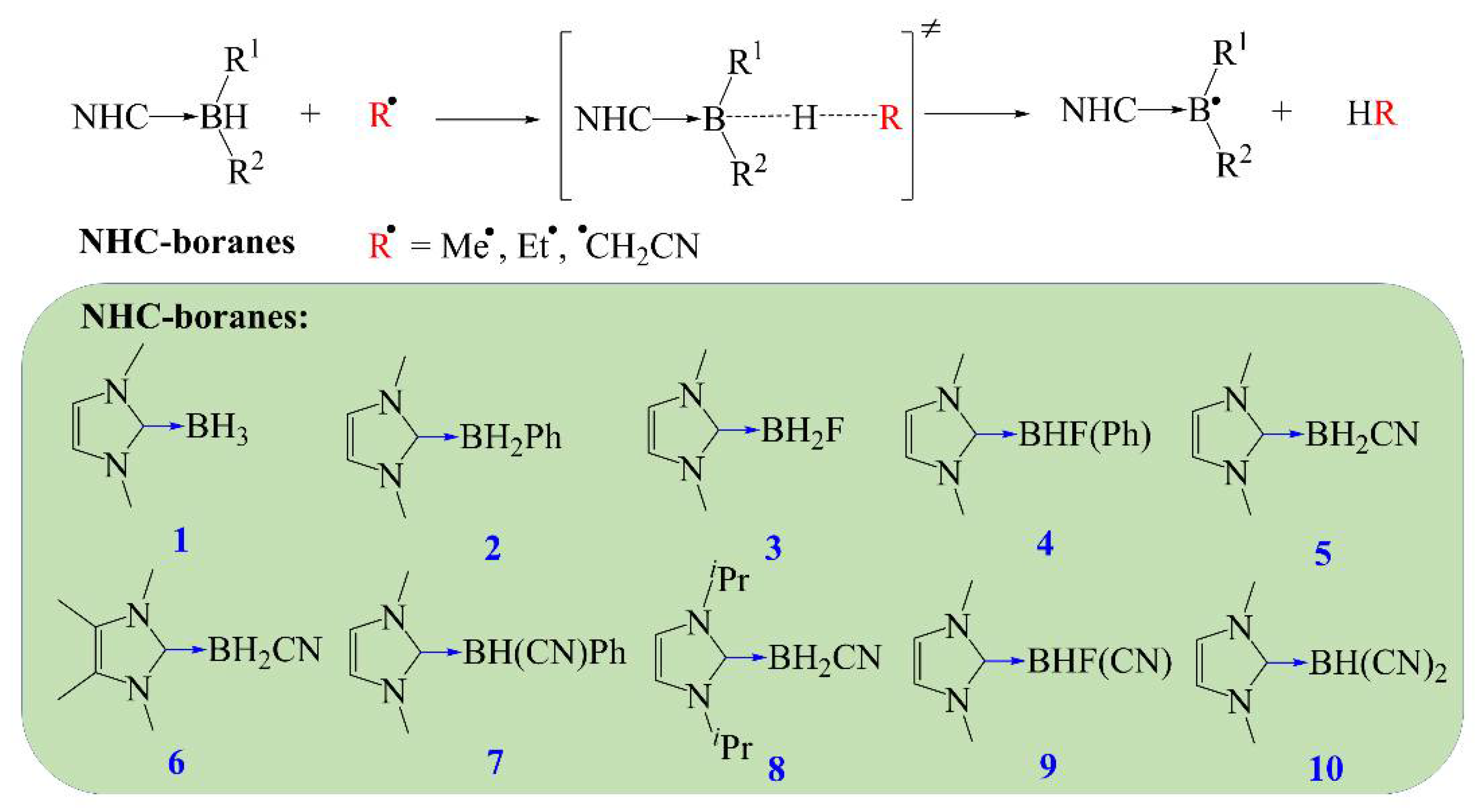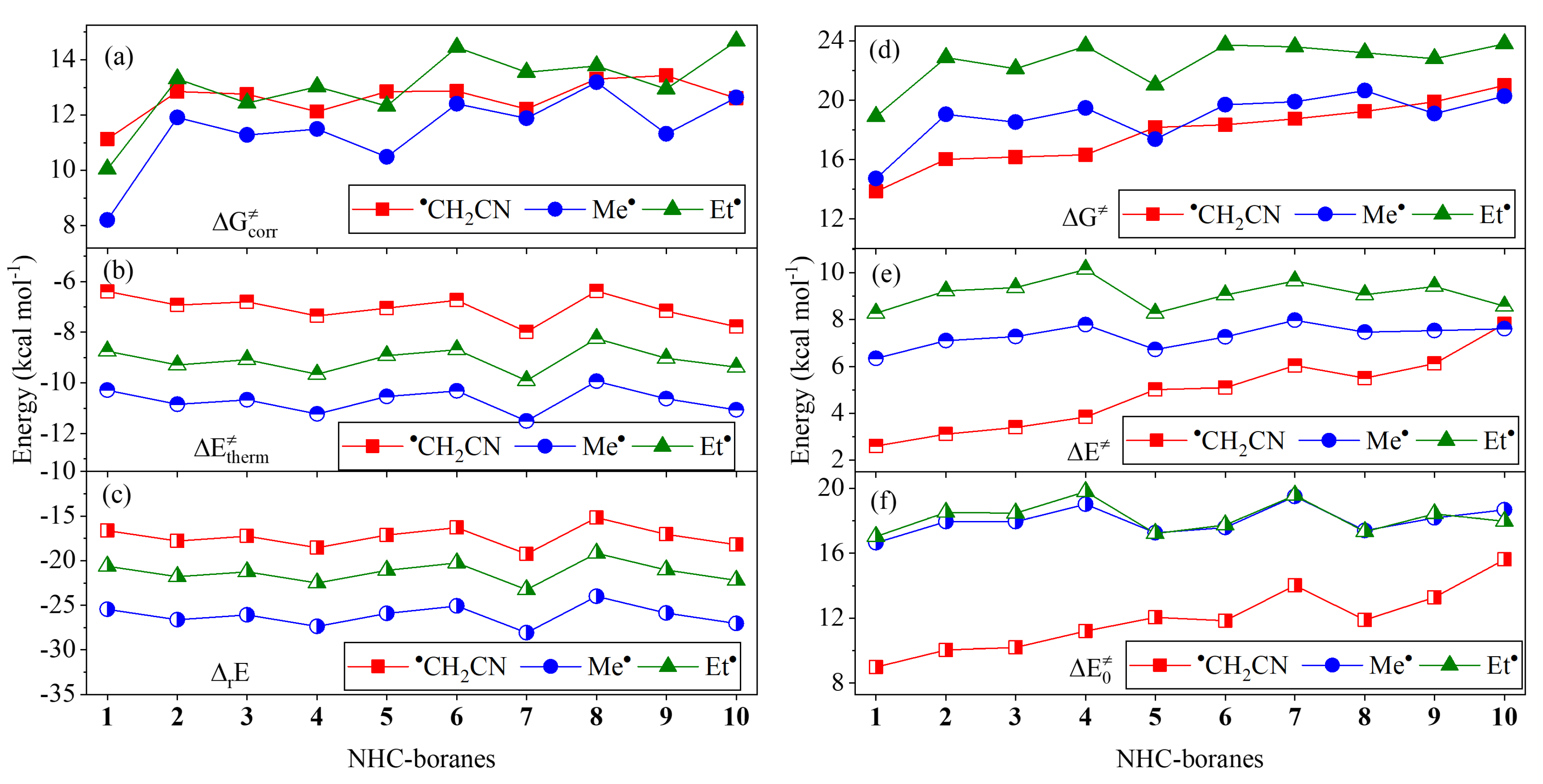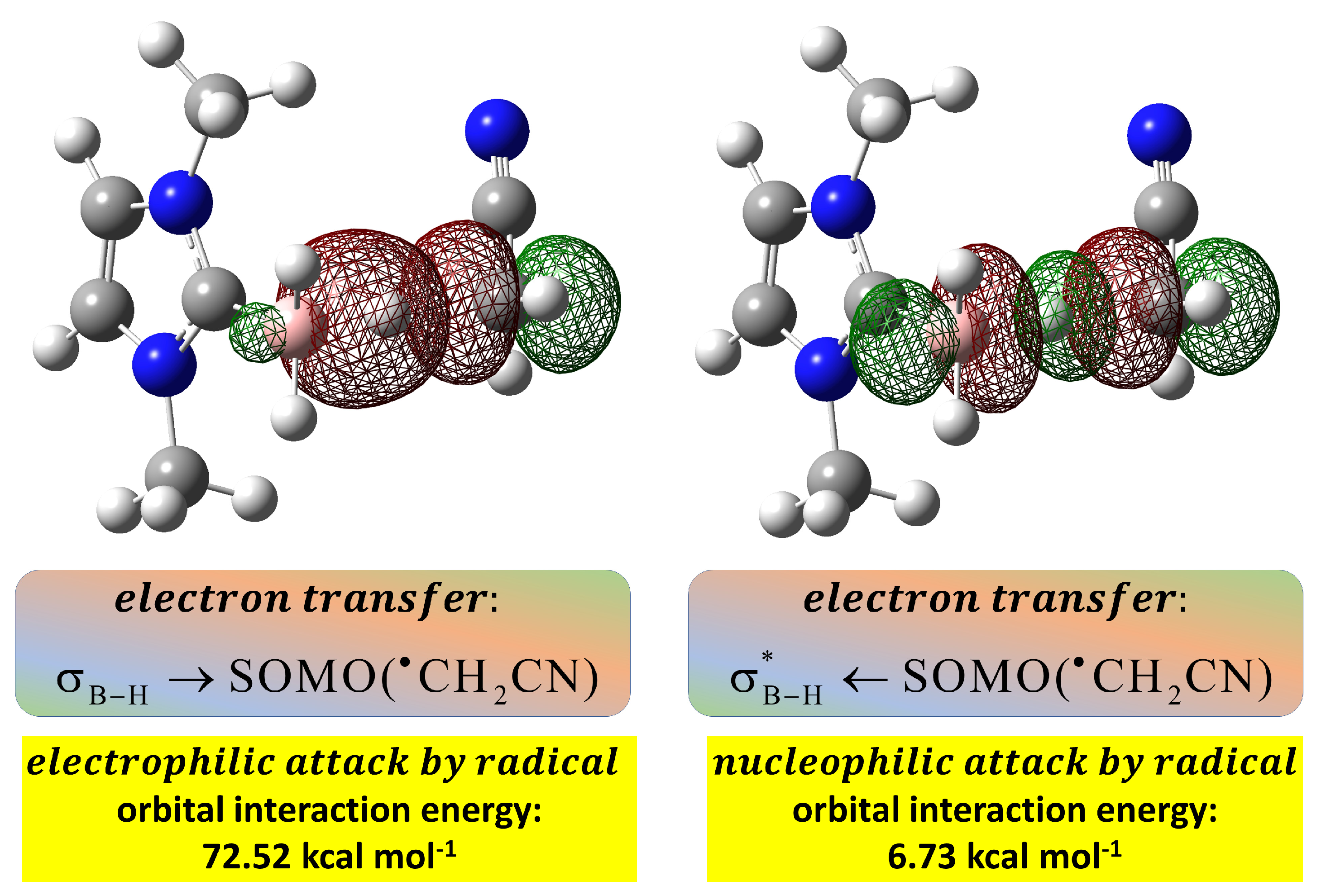DFT Investigation of Hydrogen Atom Abstraction from NHC-Boranes by Methyl, Ethyl and Cyanomethyl Radicals—Composition and Correlation Analysis of Kinetic Barriers
Abstract
:1. Introduction
2. Results and Discussion
2.1. Activation and Intrinsic Barriers and Thermal Contribution
2.2. Free Energy Barrier
2.3. Understanding Barriers and Reactivities Based on the Polarity Effect
2.4. Bond Dissociation Energies
3. Computational Details
4. Conclusions
Supplementary Materials
Author Contributions
Funding
Acknowledgments
Conflicts of Interest
References
- DeFrancesco, H.; Dudley, J.; Coca, A. Boron Chemistry: An Overview. In Boron Reagents in Synthesis, 2nd ed.; Coca, A., Ed.; American Chemical Society: Washington, DC, USA, 2016; Volume 1236, pp. 1–25. [Google Scholar]
- Braunschweig, H.; Dewhurst, R.D.; Hammond, K.; Mies, J.; Radacki, K.; Vargas, A. Ambient-temperature isolation of a compound with a boron–boron triple bond. Science 2012, 336, 1420–1422. [Google Scholar] [CrossRef] [PubMed] [Green Version]
- Braunschweig, H.; Dewhurst, R.D. Boron−Boron multiple bonding: From charged to neutral and back again. Organometallics 2014, 33, 6271–6277. [Google Scholar] [CrossRef]
- Staubitz, A.; Robertson, A.P.M.; Sloan, M.E.; Manners, I. Amine- and phosphine-borane adducts: New interest in old molecules. Chem. Rev. 2010, 110, 4023–4078. [Google Scholar] [CrossRef] [PubMed]
- Curran, D.P.; Solovyev, A.; Brahmi, M.M.; Fensterbank, L.; Malacria, M.; Lacôte, E. Synthesis and reactions of N-heterocyclic carbene boranes. Angew. Chem. Int. Ed. 2011, 50, 10294–10317. [Google Scholar] [CrossRef] [PubMed]
- Nesterov, V.; Reiter, D.; Bag, P.; Frisch, P.; Holzner, R.; Porzelt, A.; Inoue, S. NHCs in main group chemistry. Chem. Rev. 2018, 118, 9678–9842. [Google Scholar] [CrossRef] [PubMed]
- Taniguchi, T. Boryl radical addition to multiple bonds in organic synthesis. Eur. J. Org. Chem. 2019, 6308–6319. [Google Scholar] [CrossRef]
- Staemmler, V.; Jungen, M. Ab initio calculations of small hydrides including electron correlation. The two lowest states of the BH2 radical. Chem. Phys. Lett. 1972, 16, 187–191. [Google Scholar] [CrossRef]
- Rablen, P.R. Large effect on borane bond dissociation energies resulting from coordination by Lewis bases. J. Am. Chem. Soc. 1997, 119, 8350–8360. [Google Scholar] [CrossRef]
- Barreto, P.R.P.; Vilela, A.F.A.; Gargano, R. Thermochemistry of molecules in the B/F/H/N system. Int. J. Quantum Chem. 2005, 103, 659–684. [Google Scholar] [CrossRef]
- Murdoch, J.R. Barrier heights and the position of stationary points along the reaction coordinate. J. Am. Chem. Soc. 1983, 105, 2667–2672. [Google Scholar] [CrossRef]
- Donnella, J.; Murdoch, J.R. Application of Marcus-like equations to group-transfer reactions. A theoretical test of intrinsic barrier additivity and the “Square” relationship. J. Am. Chem. Soc. 1984, 106, 4724–4735. [Google Scholar] [CrossRef]
- Carboni, B.; Monnier, L. Recent developments in the chemistry of amine- and phosphine-boranes. Tetrahedron 1999, 55, 1197–1248. [Google Scholar] [CrossRef]
- Allen, T.H.; Curran, D.P. Relative reactivity of stable ligated boranes and a borohydride salt in Rhodium(II)-catalyzed boron−hydrogen insertion reactions. J. Org. Chem. 2016, 81, 2094–2098. [Google Scholar] [CrossRef] [PubMed]
- Kuhn, N.; Henkel, G.; Kratz, T.; Kreutzberg, J.; Boese, R.; Maulitz, A.H. Derivate des Imidazols, VI. Stabile Carben-Borane. Chem. Ber. 1993, 126, 2041–2045. [Google Scholar] [CrossRef]
- Ueng, S.-H.; Fensterbank, L.; Lacôte, E.; Malacria, M.; Curran, D.P. Radical deoxygenation of xanthates and related functional groups with new minimalist N-heterocyclic carbene boranes. Org. Lett. 2010, 12, 3002–3005. [Google Scholar] [CrossRef]
- Bolt, D.A.; Curran, D.P. 1-Butyl-3-methylimidazol-2-ylidene borane: A readily available, liquid N-heterocyclic carbene borane reagent. J. Org. Chem. 2017, 82, 13746–13750. [Google Scholar] [CrossRef]
- Gardner, S.; Kawamoto, T.; Curran, D.P. Synthesis of 1,3-dialkylimidazol-2-ylidene boranes from 1,3-dialkylimidazolium iodides and sodium borohydride. J. Org. Chem. 2015, 80, 9794–9797. [Google Scholar] [CrossRef]
- Walton, J.C. Linking borane with N-heterocyclic carbenes: Effective hydrogen-atom donors for radical reactions. Angew. Chem. Int. Ed. 2009, 48, 1726–1728. [Google Scholar] [CrossRef]
- Ueng, S.-H.; Solovyev, A.; Yuan, X.; Geib, S.J.; Fensterbank, L.; Lacôte, E.; Malacria, M.; Newcomb, M.; Walton, J.C.; Curran, D.P. N-heterocyclic carbene boryl radicals: A new class of boron-centered radical. J. Am. Chem. Soc. 2009, 131, 11256–11262. [Google Scholar]
- Dai, W.; McFadden, T.R.; Curran, D.P.; Früchtl, H.A.; Walton, J.C. 5-Endo cyclizations of NHC-boraallyl radicals bearing ester substituents: Characterization of derived 1,2-oxaborole radicals and boralactones. J. Am. Chem. Soc. 2018, 140, 15868–15875. [Google Scholar] [CrossRef] [Green Version]
- Shimoi, M.; Watanabe, T.; Maeda, K.; Curran, D.P.; Taniguchi, T. Radical trans-hydroboration of alkynes with N-heterocyclic carbine boranes. Angew. Chem. Int. Ed. 2018, 57, 9485–9490. [Google Scholar] [CrossRef]
- Solovyev, A.; Chu, Q.; Geib, S.J.; Fensterbank, L.; Malacria, M.; Lacôte, E.; Curran, D.P. Substitution reactions at tetracoordinate boron: Synthesis of N-heterocyclic carbene boranes with boron–heteroatom bonds. J. Am. Chem. Soc. 2010, 132, 15072–15080. [Google Scholar] [CrossRef] [PubMed]
- Allen, T.H.; Kawamoto, T.; Gardner, S.; Geib, S.J.; Curran, D.P. N-heterocyclic carbene boryl iodides catalyze insertion reactions of N-heterocyclic carbene boranes and diazoesters. Org. Lett. 2017, 19, 3680–3683. [Google Scholar] [CrossRef] [PubMed]
- Jin, J.-K.; Zhang, F.-L.; Zhao, Q.; Lu, J.-A.; Wang, Y.-F. Synthesis of diverse boron-handled N-heterocycles via radical borylative cyclization of N-allylcyanamides. Org. Lett. 2018, 20, 7558–7562. [Google Scholar] [CrossRef] [PubMed]
- Buñuel, E.; Cárdenas, D.J. Borylative cyclization reactions. Eur. J. Org. Chem. 2016, 33, 5446–5464. [Google Scholar] [CrossRef]
- Kawamoto, T.; Okada, T.; Curran, D.P.; Ryu, I. Efficient hydroxymethylation reactions of iodoarenes using CO and 1,3-dimethylimidazol-2-ylidene borane. Org. Lett. 2013, 15, 2144–2147. [Google Scholar] [CrossRef]
- Kawamoto, T.; Geib, S.J.; Curran, D.P. Radical reactions of N-heterocyclic carbene boranes with organic nitriles: Cyanation of NHC-boranes and reductive decyanation of malononitriles. J. Am. Chem. Soc. 2015, 137, 8617–8622. [Google Scholar] [CrossRef]
- Kawamoto, T.; Oritani, K.; Kawabata, A.; Morioka, T.; Matsubara, H.; Kamimura, A. Hydrodecyanation of secondary alkyl Nitriles and malononitriles to alkanes using DiMeImd-BH3. J. Org. Chem. 2020, 85, 6137–6142. [Google Scholar] [CrossRef]
- Roberts, B.P. Polarity-reversal catalysis of hydrogen-atom abstraction reactions: Concepts and applications in organic chemistry. Chem. Soc. Rev. 1999, 28, 25–35. [Google Scholar] [CrossRef]
- O’Reilly, R.J.; Chan, B.; Taylor, M.S.; Ivanic, S.; Bacskay, G.B.; Easton, C.J.; Radom, L. Hydrogen abstraction by chlorine atom from amino acids: Remarkable influence of polar effects on regioselectivity. J. Am. Chem. Soc. 2011, 133, 16553–16559. [Google Scholar] [CrossRef]
- Paul, V.; Roberts, B.P. Polarity reversal catalysis of hydrogen atom abstraction reactions. J. Chem. Soc. Chem. Commun. 1987, 1322–1324. [Google Scholar] [CrossRef]
- Donahue, N.M. Reaction barriers: Origin and evolution. Chem. Rev. 2003, 103, 4593–4604. [Google Scholar] [CrossRef] [PubMed]
- Van Santen, R.A.; Neurock, M.; Shetty, S.G. Reactivity theory of transition-metal surfaces: A Brønsted–Evans–Polanyi linear activation energy–Free-Energy analysis. Chem. Rev. 2010, 110, 2005–2048. [Google Scholar] [CrossRef] [PubMed]
- Levine, R.D. Free energy of activation. Definition, properties and dependent variables with special reference to “Linear” free energy relations. J. Phys. Chem. 1979, 83, 159–170. [Google Scholar] [CrossRef]
- Mayer, J.M. Understanding hydrogen atom transfer: From bond strengths to Marcus theory. Acc. Chem. Res. 2011, 44, 36–46. [Google Scholar] [CrossRef] [Green Version]
- Mayer, J.M. Simple marcus-theory-type model for hydrogen-atom transfer/proton-coupled electron transfer. J. Phys. Chem. Lett. 2011, 2, 1481–1489. [Google Scholar] [CrossRef]
- Warren, J.J.; Mayer, J.M. Predicting organic hydrogen atom transfer rate constants using the Marcus cross relation. Proc. Natl. Acad. Sci. USA 2010, 107, 5282–5287. [Google Scholar] [CrossRef] [Green Version]
- Kaila, V.R.I.; Verkhovsky, M.I.; Wikström, M. Proton-coupled electron transfer in cytochrome oxidase. Chem. Rev. 2010, 110, 7062–7081. [Google Scholar] [CrossRef]
- Weinberg, D.R.; Gagliardi, C.J.; Hull, J.F.; Murphy, C.F.; Kent, C.A.; Westlake, B.C.; Paul, A.; Ess, D.H.; McCafferty, D.G.; Meyer, T.J. Proton-coupled electron transfer. Chem. Rev. 2012, 112, 4016–4093. [Google Scholar] [CrossRef]
- Frisch, M.J.; Trucks, G.W.; Schlegel, H.B.; Scuseria, G.E.; Robb, M.A.; Cheeseman, J.R.; Scalmani, G.; Barone, V.; Mennucci, B.; Petersson, G.A.; et al. Gaussian 09, Revision C.01; Gaussian, Inc.: Wallingford, CT, USA, 2009. [Google Scholar]
- Becke, A.D. Density-functional thermochemistry. III. The role of exact exchange. J. Chem. Phys. 1993, 98, 5648–5652. [Google Scholar] [CrossRef] [Green Version]
- Lee, C.T.; Yang, W.T.; Parr, R.G. Development of the Colic-Salvetti correlation-energy formula into a functional of the electron density. Phys. Rev. B 1988, 37, 785–789. [Google Scholar] [CrossRef] [Green Version]
- Miehlich, B.; Savin, A.; Stoll, H.; Preuss, H. Results obtained with the correlation energy density functionals of becke and Lee, Yang and Parr. Chem. Phys. Lett. 1989, 157, 200–206. [Google Scholar] [CrossRef]
- Zhao, Y.; Truhlar, D.G. The M06 suite of density functionals for main group thermochemistry, thermochemical kinetics, noncovalent interactions, excited states and transition elements: Two new functionals and systematic testing of four M06-class functionals and 12 other functionals. Theor. Chem. Acc. 2008, 120, 215–241. [Google Scholar]
- McLean, A.D.; Chandler, G.S. Contracted Gaussian basis sets for molecular calculations. I. Second row atoms, Z=11–18. J. Chem. Phys. 1980, 72, 5639–5648. [Google Scholar] [CrossRef]
- Tehfe, M.-A.; Brahmi, M.M.; Fouassier, J.-P.; Curran, D.P.; Malacria, M.; Fensterbank, L.; Lacôte, E.; Lalevée, J. N-heterocyclic carbenes-borane complexes: A new class of initiators for radical photopolymerization. Macromolecules 2010, 43, 2261–2267. [Google Scholar] [CrossRef]
- Dai, W.; Curran, D.P.; Walton, J.C. EPR and preparative studies of 5-endo cyclizations of radicals derived from alkenyl NHC-boranes bearing tert-butyl ester substituents. J. Org. Chem. 2019, 84, 2102–2111. [Google Scholar] [CrossRef] [Green Version]
- Zhang, X.-H.; Wang, K.-T.; Niu, T.; Li, S.-S. Density functional study on [3+2]-dipolar cycloaddition reaction of the N-heterocyclic carbene boryl azide with olefins. Bull. Korean Chem. Soc. 2014, 35, 1403–1408. [Google Scholar] [CrossRef] [Green Version]
- Tehfe, M.-A.; Monot, J.; Brahmi, M.M.; Bonin-Dubarle, H.; Curran, D.P.; Malacria, M.; Fensterbank, L.; Lacôte, E.; Lalevée, J.; Fouassier, J.-P. N-heterocyclic carbene-borane radicals as efficient initiating species of photopolymerization reactions under air. Polym. Chem. 2011, 2, 625–631. [Google Scholar]
- Aubry, B.; Subervie, D.; Lansalot, M.; Bourgeat-Lami, E.; Graff, B.; Morlet-Savary, F.; Dietlin, C.; Fouassier, J.-P.; Lacôte, E.; Lalevée, J. A second-generation chameleon N-heterocyclic carbene−borane coinitiator for the visible-light oxygen-resistant photopolymerization of both organic and water-compatible resins. Macromolecules 2018, 51, 9730–9739. [Google Scholar] [CrossRef]
- Momeni, M.R.; Rivard, E.; Brown, A. Carbene-bound borane and silane adducts: A comprehensive DFT study on their stability and propensity for hydride-mediated ring expansion. Organometallics 2013, 32, 6201–6208. [Google Scholar] [CrossRef]
- Iversen, K.J.; Wilson, D.J.D.; Dutton, J.L. Comparison of the mechanism of borane, silane and beryllium hydride ring insertion into N-heterocyclic carbene C−N bonds: A computational study. Organometallics 2013, 32, 6209–6217. [Google Scholar] [CrossRef]
- Zhu, C.; Dong, J.; Liu, X.; Gao, L.; Zhao, Y.; Xie, J.; Li, S.; Zhu, C. Photoredox-controlled β-regioselective radical hydroboration of activated alkenes with NHC-boranes. Angew. Chem. 2020, 132, 12917–12921. [Google Scholar] [CrossRef]
- Zhou, N.; Yuan, X.-A.; Zhao, Y.; Xie, J.; Zhu, C. Synergistic photoredox catalysis and organocatalysis for inverse hydroboration of imines. Angew. Chem. 2018, 130, 4054–4058. [Google Scholar] [CrossRef]
- Tomasi, J.; Mennucci, B.; Cammi, R. Quantum mechanical continuum solvation models. Chem. Rev. 2005, 105, 2999–3094. [Google Scholar] [CrossRef]
- Tomasi, J.; Persico, M. Molecular interactions in solution: An overview of methods based on continuous distributions of the solvent. Chem. Rev. 1994, 94, 2027–2094. [Google Scholar] [CrossRef]
- Barone, V.; Cossi, M.; Tomasi, J. Geometry optimization of molecular structures in solution by the polarizable continuum model. J. Comput. Chem. 1998, 19, 404–417. [Google Scholar] [CrossRef]
- Cossi, M.; Barone, V.; Cammi, R.; Tomasi, J. Ab initio study of solvated molecules: A new implementation of the polarizable continuum model. Chem. Phys. Lett. 1996, 255, 327–335. [Google Scholar] [CrossRef]
- Cancès, E.; Mennucci, B.; Tomasi, J. A new integral equation formalism for the polarizable continuum model: Theoretical background and applications to isotropic and anisotropic dielectrics. J. Chem. Phys. 1997, 107, 3032–3041. [Google Scholar]
- Adamo, C.; Barone, V. Exchange functionals with improved long-range behavior and adiabatic connection methods without adjustable parameters: The mPW and mPW1PW models. J. Chem. Phys. 1998, 108, 664–675. [Google Scholar] [CrossRef]
- Parr, R.G.; Szentpály, L.v.; Liu, S. Electrophilicity index. J. Am. Chem. Soc. 1999, 121, 1922–1924. [Google Scholar] [CrossRef]
- Parr, R.G.; Donnelly, R.A.; Levy, M.; Palke, W.E. Electronegativity: The density functional viewpoint. J. Chem. Phys. 1978, 68, 3801–3807. [Google Scholar] [CrossRef]
- Franco–Pérez, M.; Gázquez, J.L. Electronegativities of Pauling and Mulliken in density functional theory. J. Phys. Chem. A 2019, 123, 10065–10071. [Google Scholar] [CrossRef] [PubMed]
- De Vleeschouwer, F.; Van Speybroeck, V.; Waroquier, M.; Geerlings, P.; De Proft, F. Electrophilicity and nucleophilicity index for radicals. Org. Lett. 2007, 9, 2721–2724. [Google Scholar] [CrossRef] [PubMed]
- Chattaraj, P.K.; Duley, S.; Domingo, L.R. Understanding local electrophilicity/ nucleophilicity activation through a single reactivity difference index. Org. Biomol. Chem. 2012, 10, 2855–2861. [Google Scholar] [CrossRef]
Sample Availability: Not available. |









© 2020 by the authors. Licensee MDPI, Basel, Switzerland. This article is an open access article distributed under the terms and conditions of the Creative Commons Attribution (CC BY) license (http://creativecommons.org/licenses/by/4.0/).
Share and Cite
Qu, H.-j.; Yuan, L.; Jia, C.-x.; Yu, H.-t.; Xu, H. DFT Investigation of Hydrogen Atom Abstraction from NHC-Boranes by Methyl, Ethyl and Cyanomethyl Radicals—Composition and Correlation Analysis of Kinetic Barriers. Molecules 2020, 25, 4509. https://doi.org/10.3390/molecules25194509
Qu H-j, Yuan L, Jia C-x, Yu H-t, Xu H. DFT Investigation of Hydrogen Atom Abstraction from NHC-Boranes by Methyl, Ethyl and Cyanomethyl Radicals—Composition and Correlation Analysis of Kinetic Barriers. Molecules. 2020; 25(19):4509. https://doi.org/10.3390/molecules25194509
Chicago/Turabian StyleQu, Hong-jie, Lang Yuan, Cai-xin Jia, Hai-tao Yu, and Hui Xu. 2020. "DFT Investigation of Hydrogen Atom Abstraction from NHC-Boranes by Methyl, Ethyl and Cyanomethyl Radicals—Composition and Correlation Analysis of Kinetic Barriers" Molecules 25, no. 19: 4509. https://doi.org/10.3390/molecules25194509



